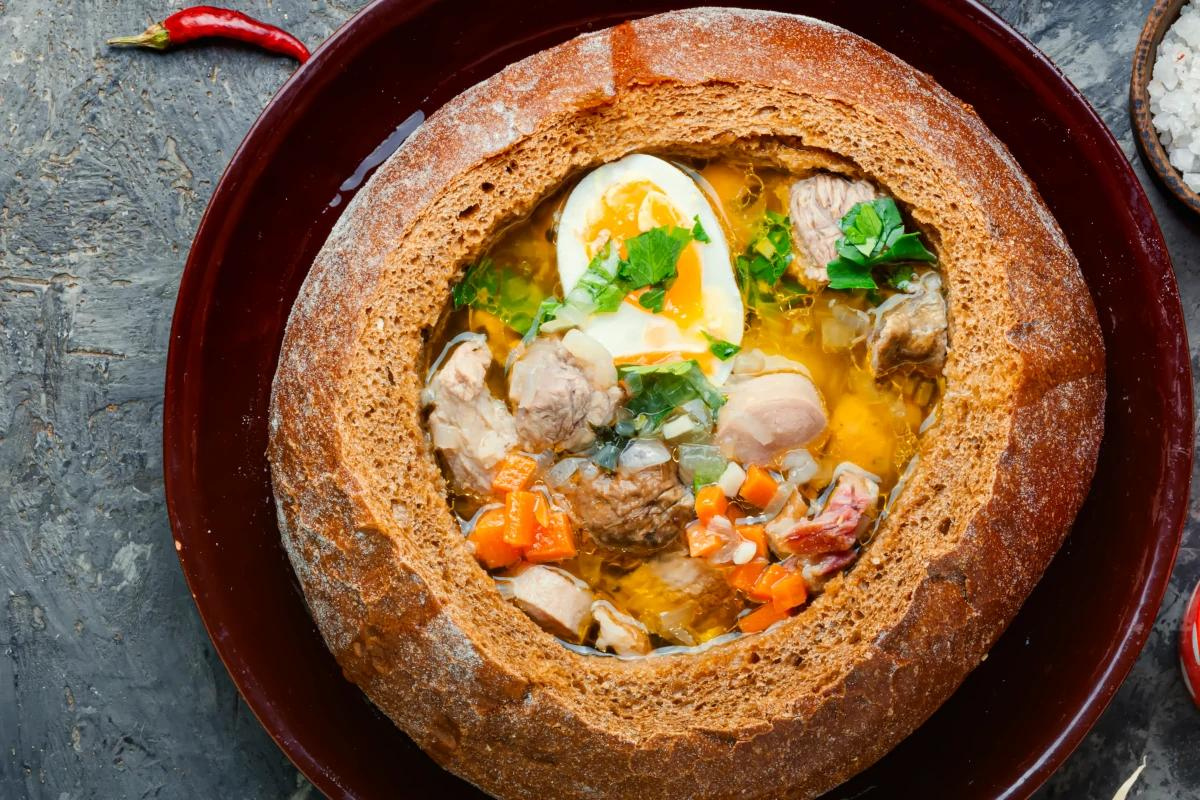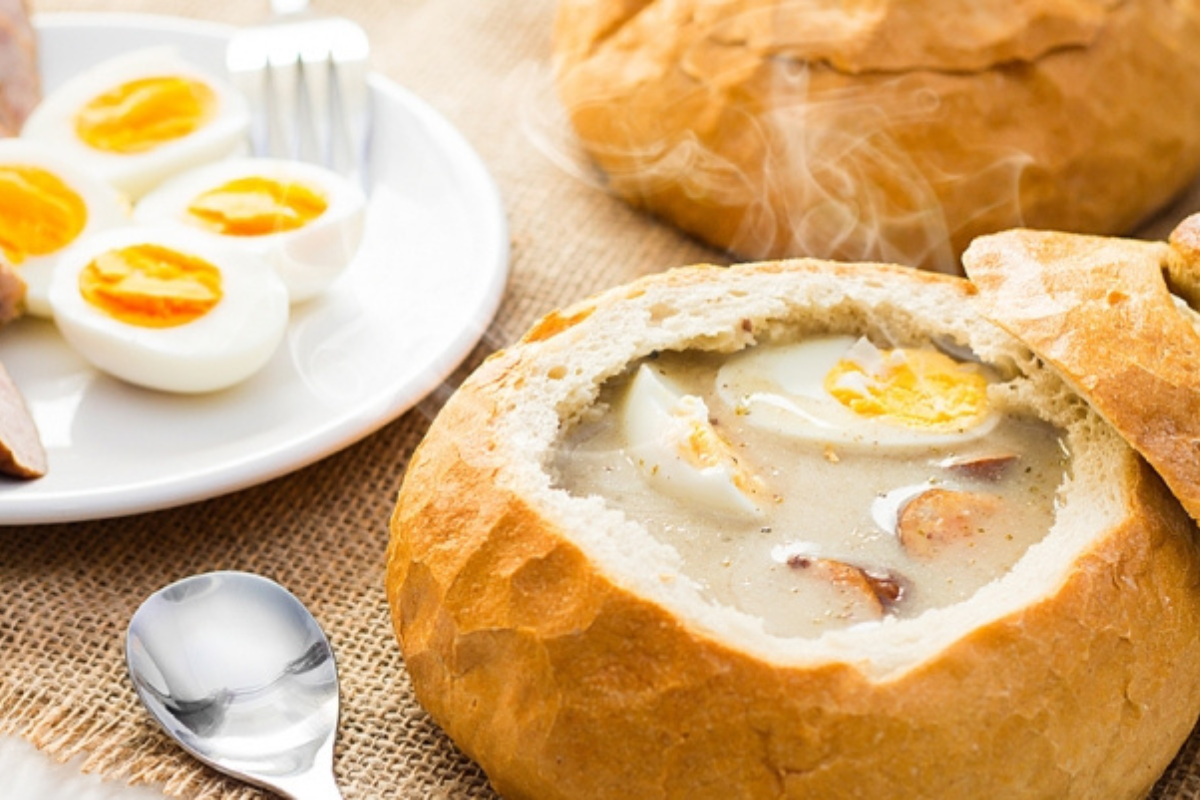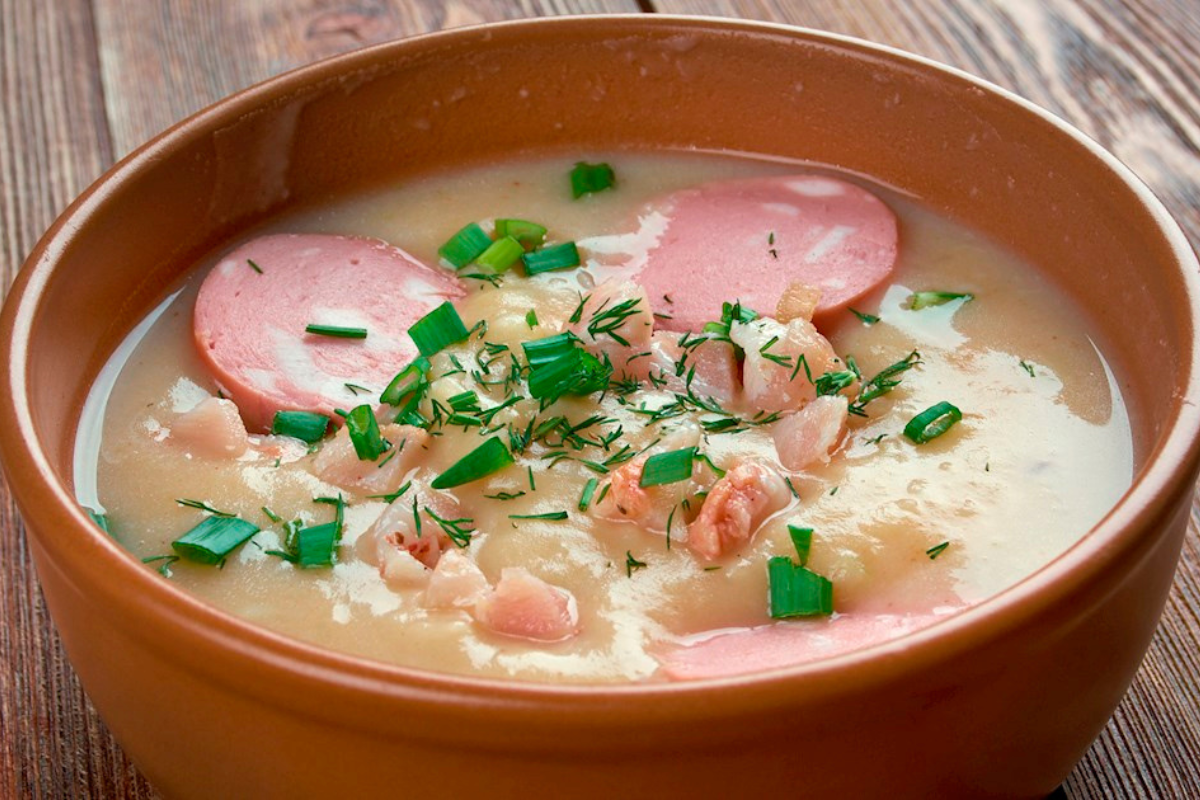More than just a delicious bowl of broth, Żurek is a cornerstone of Polish gastronomy, a dish woven into the fabric of family gatherings, festive traditions, and national identity. Its essence lies in the soul-stirring tang of fermented rye flour, a testament to the ingenuity of Polish cuisine in transforming simple ingredients into a symphony of flavors.

Photo: What About Poland?
In the heart of Polish cuisine, nestled between hearty pierogi and fluffy babka, lies a treasure unlike any other: Żurek. This seemingly simple soup, built on a foundation of fermented rye flour, is a complex tango of tangy, smoky, savory, and slightly sweet notes, all woven together by generations of tradition and love.
A fermented feast: Unraveling the soul of Żurek
The magic of Żurek begins with “żur,” a fermented rye flour starter. This centuries-old practice, akin to sourdough but with its quirky personality, imbues the soup with its characteristic tartness. The rye flour undergoes a natural lactic acid fermentation, nurtured by bacteria like Lactobacillus, which not only contribute to the unique flavor but also boast an array of digestive benefits. This sour base becomes the canvas, waiting to be splashed with vibrant strokes of other ingredients.
Żurek’s roots reach back centuries, its origins likely intertwined with peasant farmers who used leftover bread and grains to create a nourishing and flavorful meal. Over time, it evolved into a staple on Polish tables, especially during Easter. The tangy broth was believed to cleanse the palate after the winter’s rich dishes, preparing bodies and spirits for the spring and religious celebrations. Today, Żurek is enjoyed all year round, a beacon of comfort food that warms bellies and hearts alike.

Photo: KAYAK
For Poles, Żurek is a thread connecting them to their heritage. The act of making it often passed down through generations, becomes a ritual, a dance of patience and care as the żur ferments and the flavors meld. Every bowl carries the whispers of family gatherings, laughter echoing over steaming mugs, and stories shared between bites. For those far from home, Żurek becomes a portable piece of Poland, a taste of belonging that transcends borders and oceans.
Beyond the borders: Żurek’s global embrace
The world is catching on to Żurek’s charm. Its unique flavor profile, versatility, and health benefits are finding new admirers beyond Polish borders. Restaurants are adding inventive twists to the traditional recipe, while home cooks are exploring its potential through fusion dishes and creative pairings. As Żurek steps onto the global culinary stage, it carries with it not just flavor but also a piece of Polish culture, waiting to be discovered and savored.
So, raise a steaming bowl of Żurek, a toast to this humble yet magnificent soup. To its symphony of flavors, its tapestry of traditions, and its ability to connect us to something bigger than ourselves. Żurek is more than just sustenance; it’s a celebration of life, a testament to the enduring power of food to nourish both body and soul.

Photo: Love Poland
Like a chameleon adapting to its surroundings, Żurek takes on different forms depending on the region and cook. The most traditional “Żurek Staropolski” keeps it simple, celebrating the interplay of żur, smoky Polish sausage, and a hard-boiled egg nestled in the bowl. Other variations welcome potatoes, creamy sour cream, and even a splash of white wine or beer. Silesian Żurek adds a touch of sweetness with dried fruit, while Lithuanian Żurek incorporates cream and mushrooms. In some parts, Żurek is served in a bread bowl – a delightful edible vessel that soaks up the last precious drops.
Żurek’s global cousins: A tangy tale of fermented rye
While Żurek reigns supreme in Polish cuisine, its fermented rye heart connects it to a vibrant family of dishes from across the globe. Each region boasts its twist on the sour theme, offering fascinating insights into culinary ingenuity and the shared human experience of transforming humble grains into culinary treasures.
Russia’s Kisly Shchi: This hearty soup stands shoulder-to-shoulder with Żurek in terms of sour punch. Rye flour undergoes a longer fermentation process, resulting in a sharper, almost vinegar-like tang. Traditionally served with cabbage, mushrooms, and sour cream, Kisly Shchi is a perfect example of how simplicity and fermentation can create a bold and memorable flavor profile.
Germany’s Sauerampfersuppe: This German dish showcases the versatility of fermented rye beyond soups. Sauerampfer leaves a sour variety of sorrel, are combined with rye flour, and cooked into a creamy, comforting broth. Often studded with potatoes, sausages, and boiled eggs, Sauerampfersuppe offers a unique balance of tangy greens and earthy rye, proving that fermented delights can extend beyond the realm of grains.

Photo: TasteAtlas
California’s Sourdough Bread: While not a soup in the traditional sense, sourdough bread shares a deep connection with Żurek through its reliance on fermented rye starter. The tangy sourdough flavor profile, born from the same lactic acid bacteria that gives Żurek its character, adds a depth of complexity to bread, making it a beloved staple around the world.
These are just a few examples of the vast and exciting world of fermented rye dishes. Each one whispers a story of history, tradition, and adaptation, reminding us that the human palate has a universal appreciation for the transformative power of fermentation. So, the next time you savor a bowl of Żurek, remember its global family, a testament to the shared human journey of transforming simple ingredients into culinary masterpieces.

